Discover the Great Lakes waterway: Its geography, main shipping routes, cargo ports, and unique climate-related challenges.
|
Getting your Trinity Audio player ready...
|
Great Lakes facts: Location, size, and figures
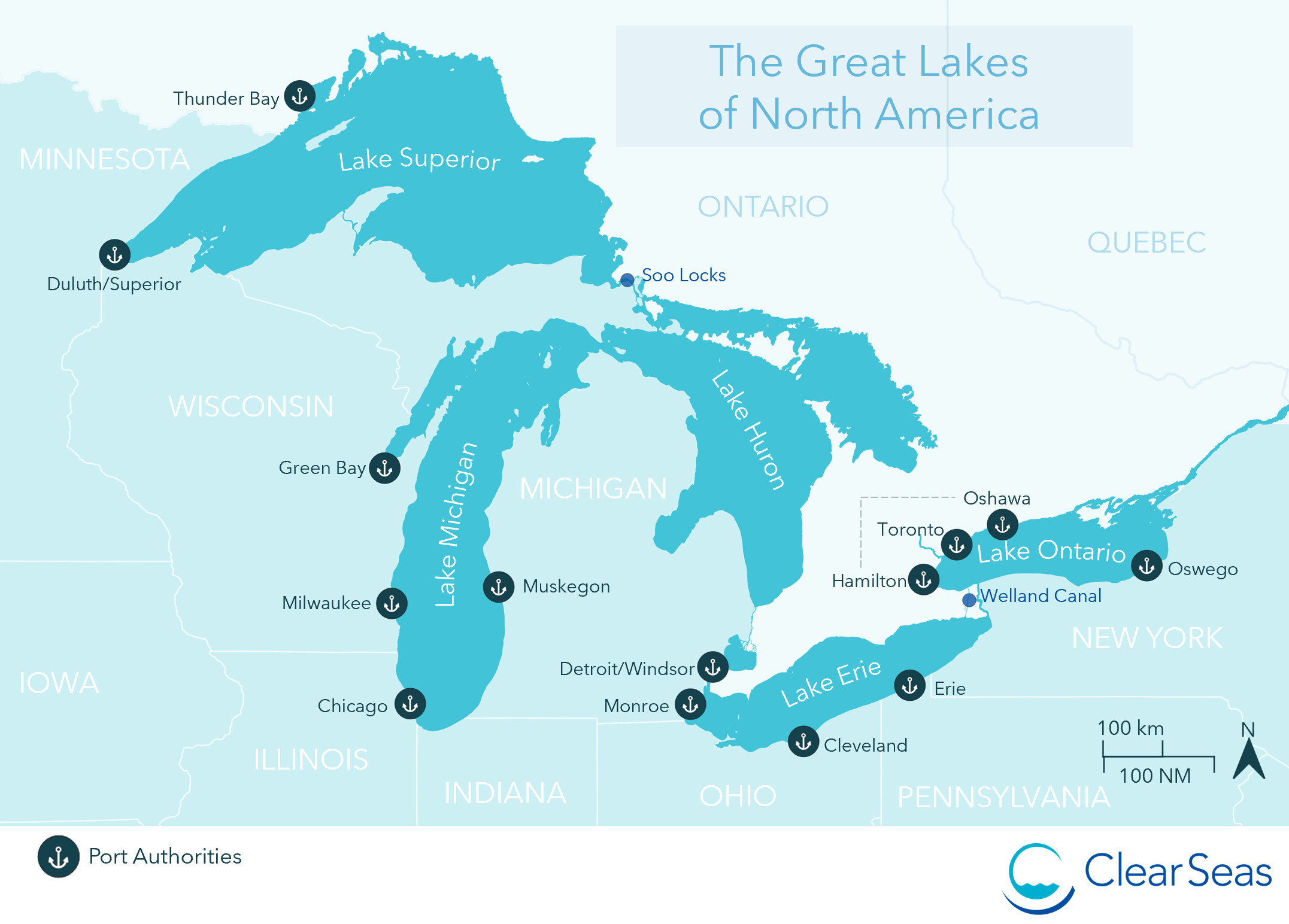
The Great Lakes are a series of five interconnected freshwater lakes – Superior, Michigan, Huron, Ontario, and Erie – located in east-central North America, near the Canada-United States border. Lake Michigan is part of the United States whereas Lakes Huron, Superior, Ontario and Erie stretch across the border, with shorelines in both countries.
Because they contain a large volume of water, the Great Lakes are often referred to as inland seas, with such characteristics as strong currents, distant horizon, great depths, rolling waves, and strong winds.1 Collectively, they account for 21% of the surface freshwater on Earth and provide a source of drinking water to approximately 28 million Canadians and Americans.1,2
The Great Lakes provide important corridors for marine trade to inland North America. From west to east, the Great Lakes waterway flows from Lake Superior to the St. Lawrence Seaway and drops approximately 180 metres in elevation as it flows from its westernmost point in Duluth, Minnesota, to the Atlantic Ocean.3
Lake Superior
Lake Superior (also referred to by the Ojibwe name Gichi-gami – gichi meaning ‘big, large, great’, gami meaning ‘water, lake sea’) is the largest Great Lake with a surface area of 82,000 km², about the same size as the country of Austria or the American state of South Carolina. It has an average depth of 147 metres, with a maximum depth of 406 metres. Lake Superior holds 12,000 km³ of water, which is enough to cover North and South America in a foot (30.5 cm) of water.1
Lake Michigan
Lake Michigan (also referred to by the Oijbwe name mishi-gami meaning ‘great water’ or ‘large lake’) is the second large Great Lake by volume with 4,900 km³ and the third largest by area (58,030 km²). It has an average depth of 85 metres, with a maximum depth of 281 metres.1 Lake Michigan connects to Lake Huron through the Straits of Mackinac, a series of short waterways between the U.S. state of Michigan’s upper and lower peninsulas. Due to this connection, Lake Michigan and Lake Huron are technically one lake, but usually considered and referred to as separate bodies of water.
Lake Huron
Lake Huron (also referred to by the Wyandot, Petun, and Huron Iroquois people by the name karegnondi meaning ‘freshwater sea’) covers approximately 59,590 km² in area and holds 3,543 km³ of water. Its average depth is 59 metres with a maximum depth of 229 metres.1 Northern parts of the Lake include the North Channel – a world-renowned cruising ground – and Georgian Bay.
Lake Erie
Lake Erie (also referred to by the Ojibwe name Waabishkiigoo-gichigami meaning ‘neutral lake’) is the second smallest Great Lake with an area of 25,667 km² and the smallest Great Lake by volume with 480 km³. The average elevation is 173 metres above sea level, and it is the shallowest Great Lake with an average depth of 19 metres and a maximum depth of 64 metres.1
Lake Ontario
Lake Ontario (whose name comes from the Wyandot word ontari’io meaning ‘lake of shining waters’) is the smallest of the Great Lakes with an area of 19,000 km². The average depth of Lake Ontario is 86 metres, and the maximum depth is 244 metres. It is the easternmost lake and the fourth smallest in volume with 1640 km³ after Lake Erie.1 Whereas the other Great Lakes are similar in elevation at around 180 metres above sea level, Lake Ontario is much lower with an elevation of 74 metres above sea level, a full 100 metres below Lake Erie.
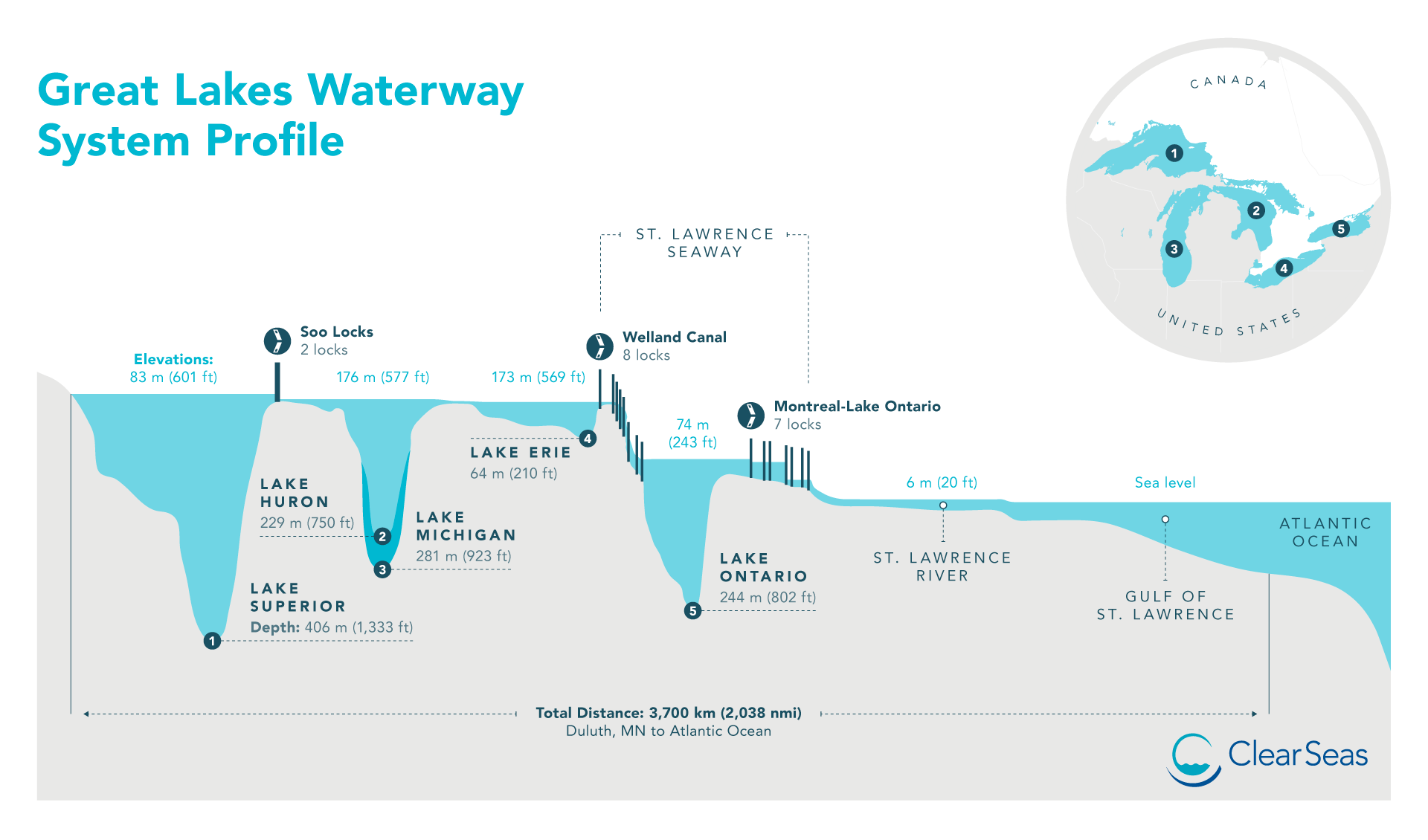
The Great Lakes shipping routes: Gateway to inland North America
The Great Lakes waterway is a major marine highway that provides a fast and effective way of transporting cargo between the Atlantic and the North American industrial heartland. The Great Lakes-St. Lawrence region has a combined gross domestic product (GDP) of over CDN$6 trillion, which would make it the third largest economy in the world if it were a country.3 Each year more than 160 million tonnes of waterborne cargo and goods are transported within the region and out to international markets.4
Brief history of the Great Lakes waterway
The Great Lakes waterway has been used as a trade route for hundreds of years and preceded other modes of modern transport. The Lakes have played a vital role for Indigenous groups in the region for millennia, many of whom belong to the Algonkian language family.5
Trade began between Indigenous communities and European settlers around the early 17th century. Soon there was competition between French, English and Dutch settlers. As trade increased and settler population grew, major cities formed as ports along the waterway, including Montreal, Toronto, and Chicago.3 During the War of 1812, several major naval battles were fought on the Great Lakes as both the United States and British North America tried to exert control over the region.6
After the construction, in 1824, of the Welland Canal connecting Lake Ontario and Lake Erie, barges from middle North America were able to reach the Atlantic Ocean from the Great Lakes. During the industrial boom in the early 20th century, the region grew into a hub for much of North America’s industrial output, including production of materials for the steel industry, such as iron ore, limestone, and coal. When the St. Lawrence Seaway opened in the 1950s, it became much easier to transport large quantities of cargo from the Great Lakes to the rest of the world.
Great Lakes ports and cargo
The Great Lakes-St Lawrence navigation system connects more than 110 commercial ports of all sizes in Canada and the United States.3 These ports are either private facilities serving host industries like mining, steel mill and power plant, public facilities managed by local government’s port agency, which is a public authority formed to operate ports with the goal of stimulating marine-related economic development and trade, or in most cases, a mix of public and private.4
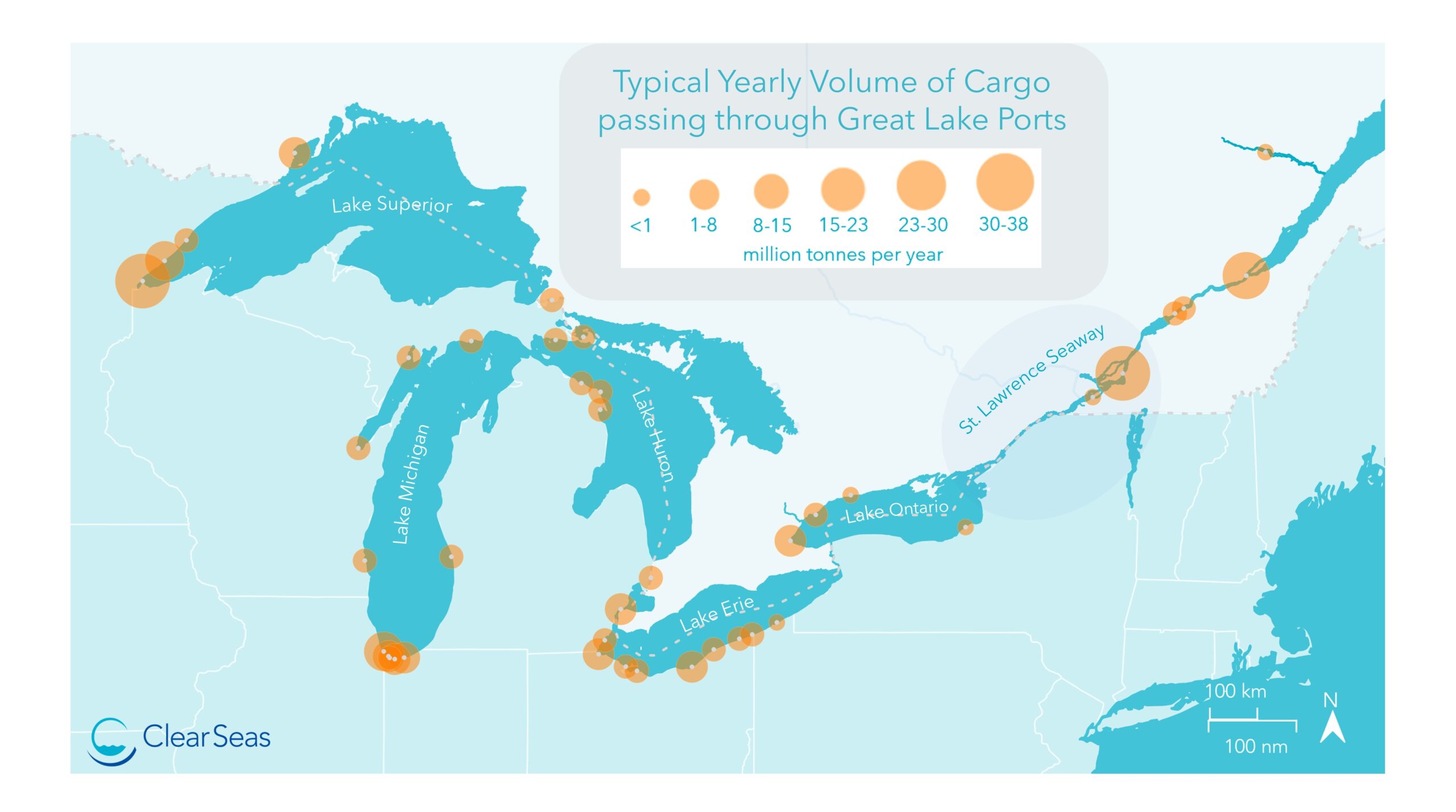
Every year between 35 to 40 million tonnes of cargo is transported along the Great Lakes St. Lawrence Seaway. Approximately two-thirds of cargo is transported downbound (toward the Atlantic Ocean) and the remaining one-third is upbound (toward the Great lakes). In total, 60 percent of cargo originates in Canada, 25 percent originates in the United States, and 15 percent is of foreign origin.7
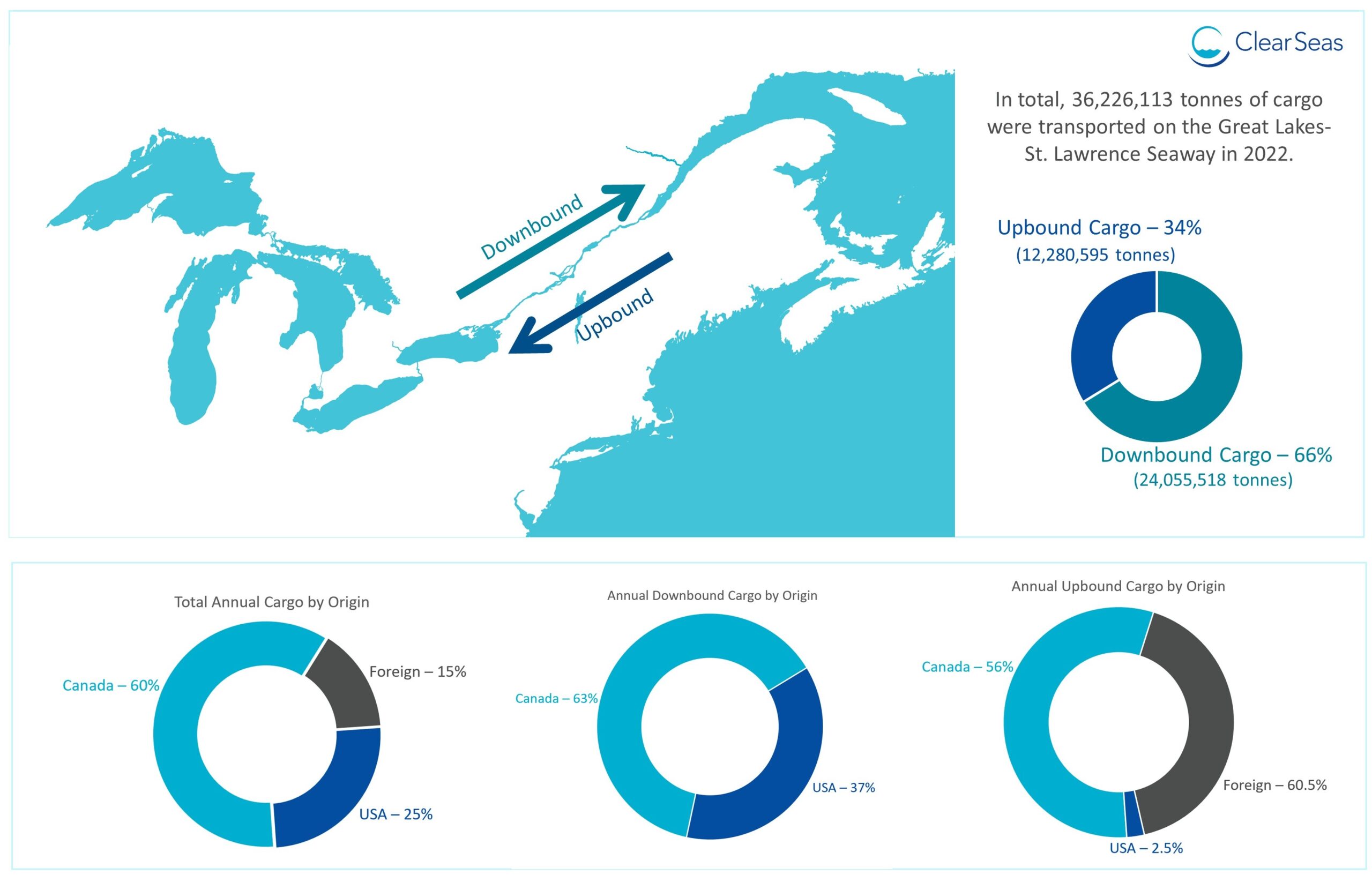
The majority of United States cargo is downbound, travelling from the United States to Canada and foreign markets. Canada, on the other hand, sends a large amount of cargo both downbound within Canada or to foreign markets and upbound within Canada or to the United States. Almost a quarter of the Great Lakes marine traffic travels to and from overseas ports, especially in Europe, the Middle East and Africa.8
What is being transported?
Most cargo transiting on the Great Lakes is bulk cargo, which is transported in large holds rather than packed in containers. Just under half of cargo consists of mining products (43%) while manufacturing products (29%) and agricultural products (28%) each make up just over a quarter of total cargo.7 Today, the primary Great Lakes cargoes include iron ore, coal, limestone, farm products (such as grain, corn, soybeans), steel, and project cargo (such as large turbine blades for wind energy projects, giant steel pressure vessels for oil refining, and railroad locomotives for export).4 Other bulk goods carried on the Great Lakes include taconite, salt, cement, gypsum, sand, slag, and potash.3

Cargo types also vary from port to port and are often related to whichever bulk product is found in that region. The U.S. Port of Duluth-Superior, located at the far western edge of Lake Superior, is the largest port on the Great Lakes and the self-proclaimed bulk capital, with an average volume of 32 million tonnes of material transported through the port per year.9 Iron ore makes up just over half of cargo (55%) transiting through the Port of Duluth-Superior. The smaller Canadian Port of Thunder Bay, located further north on the western edge of Lake Superior, has a much different breakdown of cargo type, with three-quarters of cargo (76%) made up of grain, due to its proximity to the Canadian prairies.10
Great Lakes locks and canals
Most of the waterway within the Great Lakes is navigable, except for the St. Mary’s River, from which Lake Superior drains into Lake Huron, and the Niagara River, which connects Lake Erie to Lake Ontario.
The St. Mary’s Fall Canal and Soo Locks, located at Sault Ste. Marie and built by the US Army Corps of Engineers in 1895, enable vessels to safely pass between Lake Superior and Lake Huron and bypass rapids on the St. Mary’s River. There are two parallel locks at the Soo – the MacArthur Lock, built in 1943, (maximum vessel size: 222.5 m length; 22.9 m beam; 7.7 m draft) and the Poe Lock, added in 1965, to accommodate larger vessels (335.3 m length; 32 m beam; 8.2 m draft).4 To increase the capacity of the Soo Locks, construction is underway on a new Poe-sized lock, which will take at least seven years to complete.11
The Welland Canal cuts across the Niagara Peninsula between Port Weller and Port Colborne, Ontario and includes eight locks, which lift or lower ships 100 metres from Lake Ontario to Lake Erie and bypasses Niagara Falls. The maximum vessel size for each of the eight lock chambers is 225.6 m length; 23.8 m beam; 8.1 m draft.4

A livestream of marine traffic on the Great Lakes is available here.
The Laker: A vessel designed to operate in the Great Lakes
The most common type of cargo vessel found on the Great Lakes is the American Great Lake Freighter, commonly referred to as the “Laker”. Lakers are built specifically for use within the Great Lakes-St. Lawrence Seaway System and rarely exit this waterway. The first Lakers were designed in the late 1800s. Their unique design includes vertical sides and a snub-nosed bow, which helps maximize cargo carrying capacity for their smaller size. Older Lakers were built with the bridge at the bow and a second island over the engine room in the stern, but lakers built more recently have a single island at the stern. As primarily bulk-carrying vessels, some Lakers are equipped with a self-unloading boom that contains a conveyor belt, allowing the ship to position its boom and unload bulk cargo directly onto a shore-side dock. Lakers can last for many years with less corrosion because they operate in fresh water. The average lifespan of a laker is 40-50 years.12
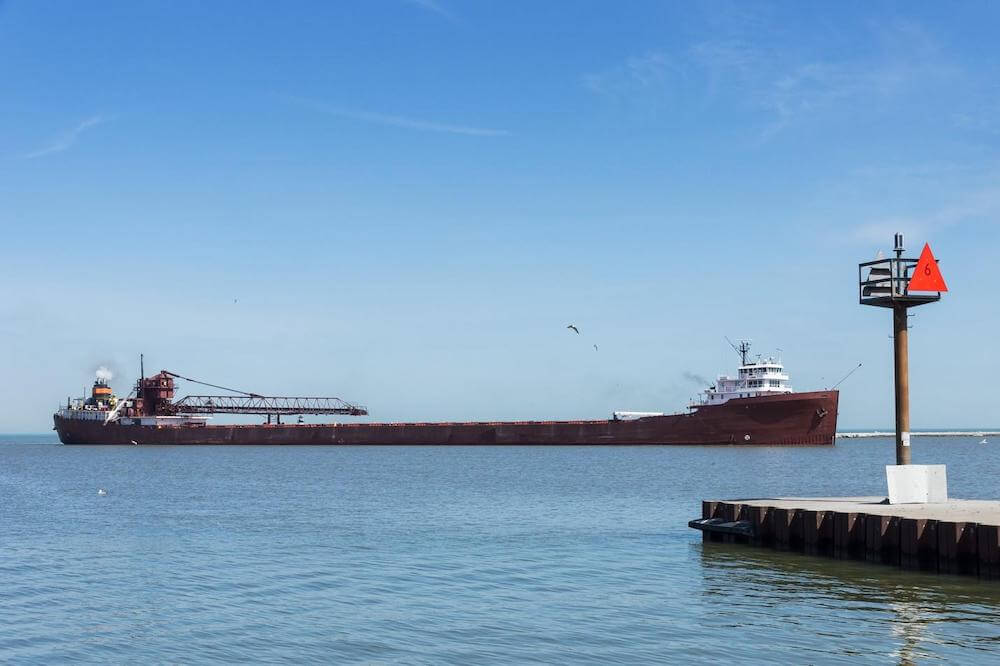
Most Lakers are subject to unique size constraints that allow them to travel from the Great Lakes waterway through the St. Lawrence Seaway to the Atlantic Ocean. The term ‘Seawaymax’ refers to the largest vessel size that can fit through the canal locks of the St. Lawrence Seaway (225.5 m length; 23.77 m beam; 8.08 m draft; 35.5 m height above water).12 Most newly built Lakers are constructed to Seawaymax limit to allow for off-Lakes use, but there are some larger freighters used on the Lakes that cannot pass to the Atlantic Ocean. These larger Lakers are confined to the upper Lakes (Superior, Huron, Michigan, and Erie) before the Seaway canal locks.
Ocean-going vessels that visit the Great Lakes are referred to as ‘salties’. While the visiting salties are small enough to fit through the canal locks and travel in all the Great Lakes, the vessels sometimes carry partial loads on the Lakes to compensate for their deeper draft (the submerged portion of the ship from the lowest point of the hull to the waterline) and lower buoyancy before ‘topping off’ upon exiting the Seaway.12
Great Lakes shipwrecks
Many shipwrecks can be found in the Lakes from over the years due to accidents and inclement weather, particularly during the stormy month of November when powerful storms track across the region.
One of the most famous vessels to have sunk in the Great Lakes was the SS Edmund Fitzgerald, an American Laker – and the first ever Seawaymax vessel – which sank in Lake Superior on November 10, 1975, while transporting iron ore during a violent storm. The sinking led to changes in Great Lakes shipping regulations and practices, such as mandatory survival suits, increased freeboard (the distance from the water level to the upper deck), and more frequent vessel inspections.

Despite the overall safety of shipping, marine incidents and accidents still occur in Canadian waters, including in the Great Lakes-St. Lawrence Seaway system. In 2017, the tanker Damia Desgagnés grounded in the St. Lawrence Seaway after an unexpected engine failure. Fortunately, no injuries to the crew and no pollution were reported. In 2018, another tanker, the Chem Norma, grounded in the same area after experiencing a mechanical failure. More information on these two maritime incidents are available in the Transportation Safety Board’s marine safety investigation reports on the grounding of the Damia Desgagnés and the Chem Norma.
Winter layup in the Great Lakes: A unique challenge
The shipping season on the Great Lakes is limited by the harsh winter. Icebreakers help keep water passage open for the fall and early winter, after which shipping usually stops for a few months during the peak of winter.
The term ‘winter layup’ refers to this winter period when large freighters are forced by snow and ice into the docks for the white season. Bringing a freighter in for layup is no easy feat once the Lakes have begun to ice over. Tugs are often used to break up the ice in shipyard’s docks and ‘wash it out’ with their propellers before bringing in the freighters. Depending on the conditions, winter docking can take anywhere from eight hours to multiple days, as ice must be continuously cleared from the bottoms of the ships’ hulls.13

Navigating the Great Lakes’ transboundary waters
The Great Lake waterway is subject to unique management due to the transboundary nature of the Great Lakes between Canada and the United States. This bi-national waterway is co-governed and co-administered by the Canadian and U.S. governments.
The International Joint Commission (IJC) is an independent binational organization established by both governments to jointly manage and protect lakes and river systems along the U.S./Canadian border.14 Most shared duties and responsibilities are outlined in the Boundary Waters Treaty, which was signed by Canada and the United States in 1909.15 The treaty provides general principles for preventing and resolving transboundary disputes, such as one country spilling hazardous materials into the other country’s waters.
Shipping vessels on the Great Lakes-St. Lawrence Seaway system belong to one of three categories: U.S.-flag operators, whose vessels are documented under U.S. law and primarily serve U.S. ports, Canadian-flag operators, whose vessels are documented under Canadian law and carry both domestic and bi-national commerce, and foreign-flag operators, whose vessels operate between Great Lake ports and overseas destinations.4
Icebreaking duties, search and rescue, and traffic services on the Great Lakes are shared by the Canadian and U.S Coast Guards, who will routinely collaborate on operations on both sides of the border as needed.16
Great Lakes shipping: Adapting to climate change
Climate change has started and will continue to bring significant changes to shipping on the Great Lakes in the coming years. Warmer water temperatures and fluctuating water levels are two factors to which the industry will have to adapt.
In recent years, warmer air temperatures on the Lakes have led to warmer surface water temperatures. This increase in temperature can contribute to lower water levels by increasing rates of evaporation and causing lake ice to form later than usual, which extends the season for evaporation. Climate models indicate that lake levels could drop as much as a metre and outflows could be reduced by 30% in the next fifty years.17 Water diversion to areas with drought may further lower lake levels.
As it becomes more difficult for vessels to safely navigate shallow areas of the Great Lakes’ channels and harbours, these vessels – particularly ocean-going ‘salties’ – must carry lighter loads to avoid running aground. Even small reductions to lake levels can cost millions of lost dollars to shipping. For example, one study found that as much as a one-metre decrease in the levels of Lake Michigan-Huron results in 3.6% to 12.2% increases in shipping costs, depending on the goods shipped and their destination.18
However, there are conflicting forecasts for Great Lake water levels, with some models showing water levels rising as extreme precipitation events increase in the region.19 This unpredictability shows that the industry must develop plans to be ready for multiple scenarios, whether the fallout of climate change relates to lower water levels or flooding from storms.
Moving toward greener Great Lakes shipping
The shipping industry – including operators, ports, and terminals – is taking steps to reduce the environmental impact of shipping globally and in the Great Lakes specifically.
Reducing greenhouse gas emissions
In 2019 alone, vessels on the Great Lakes produced 1.6 million tonnes of CO2 emissions.20
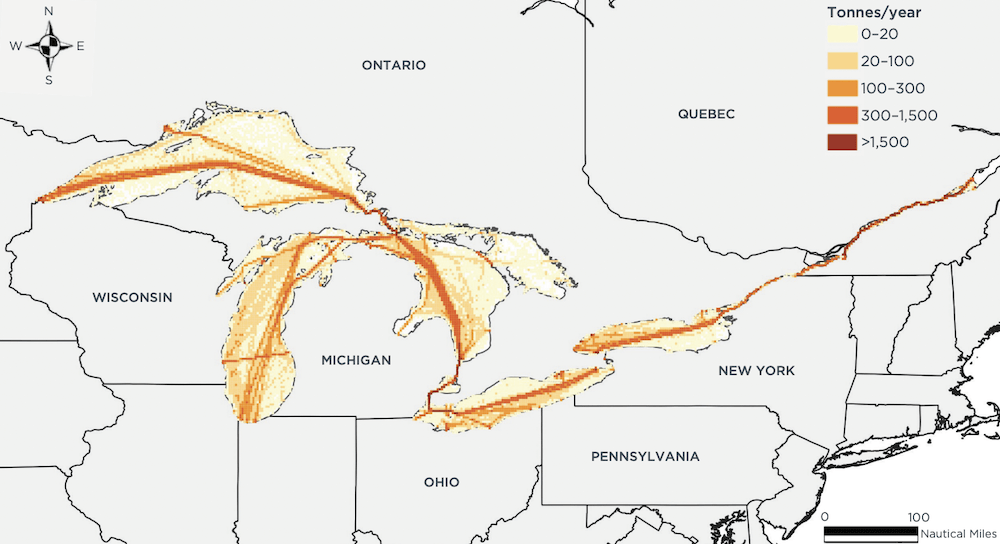
Although marine shipping is the most energy-efficient way to move large volume of cargo, several Great Lakes-St. Lawrence Seaway vessel operators are bringing new ships into service that will emit up to 45 percent less greenhouse gas (GHG) emissions than existing ships.21 The port of Milwaukee has increased its ship-to-shore capacity, which allows ships to plug in to shore electricity rather than run their engines at ports, with more ports to follow suit.
Managing ballast water
Another major area of environmental concern that has seen improvement is ballast water management to reduce the introduction of invasive species. The Great Lakes watershed includes 3,500 species of plants and wildlife and more than 250 species of fish.14 Invasive species, such as the zebra mussel, have previously been introduced by ballast water and pose a risk to the existing ecosystem.
Since 2006 new regulations have been in place that require that all ships entering the Great Lakes conduct saltwater flushing of their ballast tanks while still in the open ocean. The rules are enforced by a joint Canadian-U.S. inspection program established in Montreal, where every ocean-going ship is sampled to ensure compliance.21 While it remains difficult to control the spread of invasive species that have already been introduced to the Lakes, a recent report on the state of the Great Lakes found that prevention measures of further introduction are performing well.21
Shipping on the Great Lakes is vital to the economies of Canada and the United States. As the industry continues to evolve, safety and sustainability will be at the forefront of development.
References
1The Great Lakes By Depth. (2019). WorldAtlas.
2 United States Environmental Protection Agency & Environment and Climate Change Canada. State of the Great Lakes 2022 Report. (2022). United States Government & Government of Canada.
3Great Lakes-St. Lawrence River Shipping. (2023). Chamber of Marine Commerce.
4Industry Overview. (2023). American Great Lakes Ports Association.
5Great Lakes History: A General View. (2022). Milwaukee Public Museum.
6Osborne, L., & Callon, A. Discover the War of the Great Lakes. (2019). Great Lakes Guide.
7The St. Lawrence Seaway Traffic Report 2022 Navigation Season. (2023). St. Lawrence Seaway Management Corporation and Great Lakes St. Lawrence Seaway Development Corporation.
8Great Lakes/St. Lawrence Seaway (Highway H2O) Facts. (2023). Great Lakes St. Lawrence Seaway System.
9Port Statistics. (2022). Duluth Seaway Port Authority.
10Cargo Statistics. (2023). Port of Thunder Bay.
11Corps of Engineers awards $1.068 billion of the New Lock at the Soo Phase 3 contract. (2022). U.S. Army Corps of Engineers, Detroit District.
12Taylor, D., Hall, K., & MacDonald, N. Investigations into Ship Induced Hydrodynamics and Scour in Confined Shipping Channels. (2007). Journal of Coastal Research.
13Nelson, P. Laying up the winter fleet: Bringing Great Lakes freighters to port. (2006). Door County Living.
14Great Lakes-St. Lawrence River Watershed. (2022). International Joint Commission.
15Environment and Climate Change Canada. (2022). Canada-US boundary waters treaty. Government of Canada.
16United States Coast Guard 9th District Great Lakes. U.S., Canadian Coast Guard renew icebreaking partnership. (2018). U.S. Department of Homeland Security.
17United States Environmental Protection Agency. Climate Change Indicators: Great Lakes Water Levels and Temperatures. (2022). United States Government.
18Environmental Law & Policy Center. An assessment of the impacts of climate change on the Great Lakes. (2019).
19Kayastha, M. B., Ye, X., Huang, C., & Pengfei, X. Future rise of the Great Lakes water levels under climate change. (2022). Journal of Hydrology. https://doi.org/10.1016/j.jhydrol.2022.128205
20International Council on Clean Transportation. Great Lakes-St. Lawrence Seaway ship emissions inventory, 2019. (2019). ICCT Briefing.
21Sustainability. (n.d.). Great Lakes Seaway Partnership.



